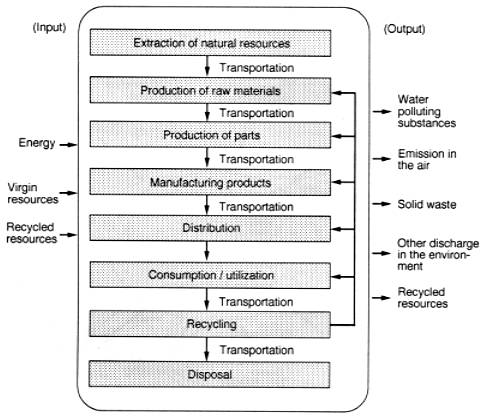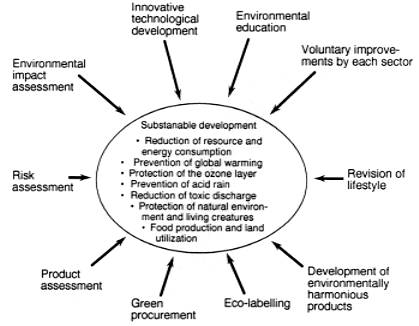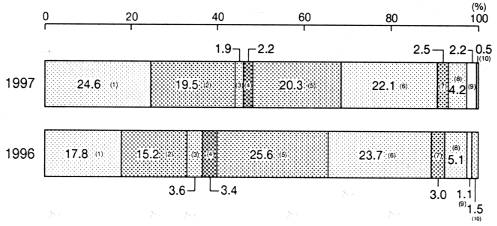Chapter I -3 :Quality of the Environment in Japan 1998
Chapter I: Towards a Socio-economic System with Environmentally Sound Material Cycles
3. Means to realize economic and social systems with high environmental efficiency
The concept of Environmental Efficiency
Environmental efficiency is a concept concerning the environmental load generated in the production stage of goods and services. Suppose that there are two sets of goods or services with identical functions or roles - the goods or service that entails less environmental load in their production or roles are the ones that have the higher environmental efficiency.
If social costs arising as a result of environmental impacts are to be internalized properly, the reduction of such impacts from production and consumption of goods and services can be an economic merit, thus the impacts can be reduced through the market mechanism.
Environmental efficiency can be increased by reducing environmental impacts at each stage in the life cycle of goods and services, i.e. the stages of production, utilization and disposal. Environmental efficiency can also be increased by revising the ways in which goods and services are offered to consumers. It can be expected that by increasing the size of the service industry environmental impacts can be reduced without slowing down economic activities.
For the realization of environmental efficiency: Life Cycle Assessment (LCA)
LCA is a method of quantitative and objective assessment of environmental impacts on the resource base, as well as waste emissions and their impacts upon the earth and ecosystems. LCA applies these considerations at all stages of the life cycle of certain goods from the acquisition of raw materials to production, utilization, disposal and transportation.
Conceptual Chart of Life Cycle and Environmental Load
Source: Environment Agency
LCA can be applied for various purposes, for example to assess the value of alternative goods and services from the viewpoint of environmental load set against the benefits that are derived from the use of the goods or service. Also, LCA is being considered for application in deciding criteria for eco-label certification and environmental household accounting.
Some aspects of the life cycle of goods and services cannot be measured quantitatively, and currently certain methods are being investigated to assess such aspects based on qualitative information, in order that LCA can be applied on a more thorough and comprehensive basis.
LCA for Sustainable Development

Source: Compiled by the Environment Agency from the report of the LCA Japan Forum
Establishment of environmental management systems
Environmental management is an initiative undertaken by a commercial enterprise to establish voluntary environmental policy and goals, and to carry out measures to achieve these goals. Establishing an environmental management system requires establishing systems and procedures within the factory or business premises. With the establishment of an environmental management system various merits can be expected: it can not only facilitate the reduction of environmental impacts but also can raise environmental awareness on the part of workers and serve as an incentive for more active environmental protection.
As of the end of March 1998, 861 companies in Japan are registered for assessment under ISO14001 standards. The breakdown by industry is: electrical machine manufacturing 53.1 %, general machine manufacturing 11.8%, chemical industry 7.3%, precision machine manufacturing 6.5%, and transport machine manufacturing 4.3%. These major manufacturing industries account for over 80% of the total number of companies. Meanwhile the number of registrations for assessment under ISO14001 is increasing in the service industry, and the implication is that the concept of environmental management is spreading throughout the commercial sector.
Response to the ISO Environmental Management System
(Companies with listed stock)

- (1)
- Acquired, or with plans to acquire, ISO certification at all offices.
- (2)
- Acquired, or with plans to acquire, ISO certification at some offices.
- (3)
- Established a system following the ISO standards, but did not receive certification.
- (4)
- Established a system regardless of ISO.
- (5)
- Interested in ISO system and collecting information.
- (6)
- Interested in ISO system, but no action has been taken.
- (7)
- No particular interest.
- (8)
- Does not know much about ISO.
- (9)
- Others.
- (10)
- Not known.
Source: Survey on Environmentally Friendly Company Activities (1997)
Environmental reports
Environmental reports are written and made public by companies concerning the extent of environmental impacts caused by their own business operations. Environmental reports also describe the voluntary measures that the issuing company is making to reduce such impacts. The contents of such reports include the companies' "environmental management" such as environmental policy, goals and plans, the organizational system for implementing measures taken for ISO14001 registration, and also measures taken for reducing environmental impacts such as the reduction of CO2 emission and reduction and recycling of wastes.
Environmental accounting
It is very important to make clear how much cost is entailed in the environmental preservation activities of companies, because the activities cannot be carried out efficiently or effectively without meeting the pertaining costs. Thus environmental accounting is used to manage expenditure for the implementation of environmental management and it plays a significant role as an internal management tool for voluntary environmental preservation activities undertaken by the corporate sector.
The costs of environmental preservation activities are mentioned in recent environmental reports. In this respect environmental accounting can serve as a financial accounting which is reported to external interest groups and individuals.
Eco-labelling
Eco-labelling is a means of providing information on the extent and specific description of the environmental impacts generated by various products. In general ecolabels are used to differentiate products by providing information regarding the environmental impacts of the products .
Recognition of environmental risks and company behavior: PRTR system
PRTR (Pollutant Release and Transfer Registration) is recommended by OECD and other bodies as a method to be used by companies to identify environmental risks which accompany their business operations and to promote appropriate management strategies.
Each sector of society benefits from the application of PRTR. Through PRTR, governments can gather information on the release and transfer of pollutants, thus improving overall management of chemical substances. Companies benefit by realizing the status of pollutant discharge and transport. This will facilitate proper management for their own operations. For citizens PRTR would serve as a basis for participation in the policymaking process.
PRTR Systems in Different Countries
| Countries | PRTR System | Governing Law | Targeted Substances | Targeted Facilities | Public Announcement |
|---|---|---|---|---|---|
| U.S.A. | TRI (Toxic Chemical Release Inventory) | Emergency Planning and Community Right-to-Know | About 650 kinds | Manufacturing facilities, federal facilities (with over a certain number of staff and a certain amount of annually acquired chemical substances) | Announcement of individual data. |
| Canada | NPRI (National Pollutant Release Inventory) | Canadian Environmental Promotion Act | About 180 kinds | Manufacturing facilities (with over a certain number of staff and a certain amount of annually acquired chemical substances) | Announcement of individual data. |
| Holland | EIS (Emission Inventory System) | Environmental Management Act | About 170 kinds | Facilities requiring permission under the terms of the Environmental Management Act | Announcement of total data. Individual data to be provided upon request. |
| U.K. | CRI (Chemical Release Inventory) | Environmental Protection Act 1990 | About 500 kinds | Facilities requiring certain processes under the terms of the Environmental Protection Act (Types of business are listed.) | Announcement of total data. Individual data to be provided upon request. |
Towards an environmentally efficient economic/social system
It is expected that by using such tools as explained above, companies can achieve higher environmental efficiency and greatly increase environmental considerations pertaining to their operations. At OECD, the improvement of environmental efficiency is considered to be a link between economic activities and environmental impacts. A simple and high quality index is under consideration which would help companies devote more attention to environmental efficiency when it comes to the decision-making process. If this index is established and used by all the various economic sectors it will be helpful in improving environmental efficiency. Goods and services with higher environmental efficiency can be chosen, and the OECD's index is expected to help producers and consumers make their own behavior more environmentally friendly.